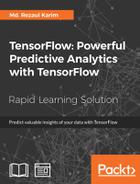In this lesson, we have discussed a wonderful field of machine learning called reinforcement learning with TensorFlow. We have discussed it from the theoretical as well as practical point of view. Reinforcement learning is the natural tool when a problem can be framed by states that change due to actions that can be taken by an agent to discover rewards. There are three primary steps in implementing the algorithm: infer the best action from the current state, perform the action, and learn from the results.
We have seen how to implement RL agents for making predictions by knowing the action, state, policy, and utility functions. We have seen how to develop RL-based agents using random policy as well as neural network-based QLearning policy. QLearning is an approach to solve reinforcement learning, where you develop an algorithm to approximate the utility function (Q-function). Once a good enough approximation is found, you can start inferring best actions to take from each state. In particular, we have seen two step-by-step examples that show how we could develop a multiarmed bandit agent and a stock price prediction agent with very good accuracy. But, be advised that the actual stock market is a much more complicated beast, and the techniques used in this lesson generalize too many situations.
This is more or less the end of our little journey with TensorFlow. I hope you'd a smooth journey and gained a lot of knowledge on TensorFlow.
I wish you all the best for your future projects. Keep learning and exploring!
